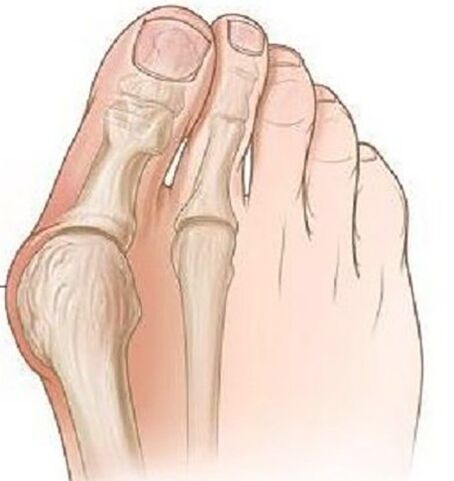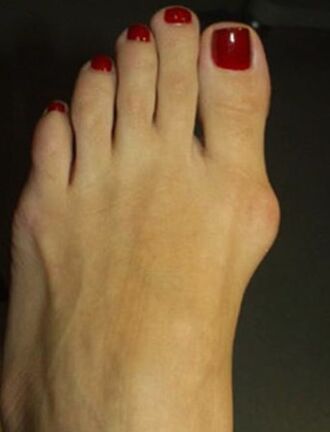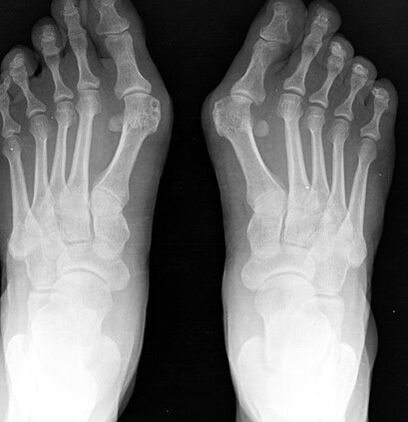Valgus deformation of the thumb of the foot is the most common acquired deformation of the foot, which is characterized by the deviation of the thumb outside.
The pathology has bilateral nature, mainly affects women over 35 years.In most cases, the deformity is accompanied by chronic inflammation of the joint sac and deformation of arthrosis of the plusfalang joints, pronerational abnormalities of the first metatarsal bone.

Causes of the disease.Why is it dangerous?
The etiological causes of Valgus deviations of the thumb of the foot have not yet been fully studied.There are several theories for an event:
- Westigial theory.In the mid -19th century, it was believed that only models were the subject of this deformation due to the use of high -level model shoes, but during the study, this pathology was discovered in men who wear flat shoes.
- The theory of primary muscle weakness - was refuted in a detailed study of the problem.
- The theory of the weakness of the ligament apparatus and the lack of aponeurosis of the only one - most scientists adhere to this theory.
There are a number of factors leading to the debut of this pathology:
- Excessive weight, increase in the load of the legs.
- Dystrophic changes in the joint age -related apparatus.
- Weekens of heels with heels are more than 5 cm narrowed to the finger.
- Existing deformities of the skeleton (scoliosis, deformity of valgus of the femur and knee joints, flat legs).
The danger of the pathology lies in the fact that over time this deformity leads to deformation of the posture, it is possible to develop dystrophic depths of the spine, hip and knee joints due to improper distribution of the load during walking, the injury of the man is accompanied by a significant pain.
Clinical manifestations
At the onset of the disease, Valgus deformity is not clinically shown.Most women are more concerned about the appearance of an enlargement of the legs of the metacarpal-phalanx and the outburst of the first finger becomes noticeable.

Over time, pain occurs, first when wearing tight shoes and long walking, and later the pain begins to be constant, sick.
Due to the incorrect weight distribution, the limb, from the first and second finger on the sole, is formed by calluses, the second finger is lifted, highly elongated, "Masles" fingers are formed, which significantly complicates walking.Due to the deterioration of blood circulation and innervation in the front of the foot, arthrosis and chronic bursitis develop.
Diagnostics
- During an objective study, a classic deformation with valgus abnormalities of the thumb is seen, the distal part of the foot is expanded.In the projection of the head of the first metatarsal bone there are signs of bursitis - hyperemia and swelling of the skin, pain during palpation.
- The radiography of the foot in two projections.The anterior projection determines the degree of the thumb, the condition of the metacarpal-phalax joint, the degree of displacement of the sesamoid bone, and in the lateral projection the degree of flat legs is visualized and calculated, which is very common with deviations of valgus on the first toe of the foot.
- Platoography.On the footprint of the foot made on paper, a line is outlined through the center of the heel and between the fourth and third fingers, the outer set of the foot is formed figuratively, according to which the presence of a flattening of the foot and its degree is evaluated.In these patients, a flattened leg or flat legs of 1 degree is more commonly found.
Treatment and prevention
Depending on the severity of the process, conservative or surgical treatment is performed.
Conservative treatment is performed in the mild stage of the disease, different types of orthopedic insoles are used, which are selected individually and remove the deformed finger to the normal position, while the load on the front of the limb is stabilized and distributed.
In the infant and senile era, a transverse dressing of the distal limb is used with laying between the first and second finger.To reduce the pain, warm baths with sea salt and soda are used, radoned baths give a good result.
Local anti -inflammatory gels are used to combat bursitis, compresses with demexide and lidocaine are used, and with pronounced pain, blockade of novocaine and intra -articular injections of glucocorticoids.

Surgical treatment is possible at every stage of the disease, it is performed with local anesthesia, which reduces the list of contraindications for surgery.
In the first stage, bone growth is removed on the inner edge of the bone, while it is only possible to reduce the pain of the process, but not to prevent the development of deformation in the future.
With severe finger deviation with the presence of flat legs, an osteotomy is performed at the base of the plus bone of the first toe, using a bone blade to reject the finger in the normal position, with the help of a laurean strip the transverse ligament of the sole is formed.After surgery, the leg is tightly fixed with a bandage for 4 weeks, it is recommended to use individual orthopedic insoles during the year.
Preventing the disease is to use comfortable high -heeled shoes, the shoes should sit on the feet loose, a narrow toe should not carry discomfort in the thumb.If there are any deformities of the skeleton, it is recommended to undergo preventive examinations in the orthopedist in order to identify and slow down the progression of the deformation of the valgus of the thumb of the foot.
Consequences and complications
A complication of the process is the development of Deichländer or the "march" of the foot, which is characterized by acute pain, due to the micro -spots in the pairing joints of the foot and tendovaginitis.
Due to the constant inflammatory process and mechanical damage, there is a risk of developing malignant neoplasms of the bone.























